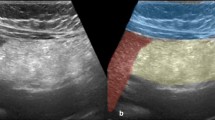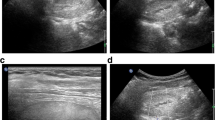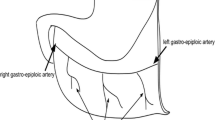Abstract
Background
Omental infarction is a rare cause of an acute abdomen with nonspecific signs that can be easily mistaken with other more common intra-abdominal pathologies. The increased use of radiological imaging has brought this diagnosis to attention with respect to management plan. We present the experience of an Australian hospital network with the diagnosis and management of omental infarction to raise awareness of this uncommon pathology.
Methods
A retrospective review of medical records of adult patients diagnosed with omental infarction from 2010 to 2020 was conducted across four major hospitals in South Western Sydney. Data relating to clinical presentation, investigations, management and outcomes were obtained.
Results
Omental infarction was diagnosed in 61 patients (mean 51.1 years, range: 19–76 years old). All patients presented with nonspecific abdominal pain with the most common sites being the right iliac fossa followed by the right upper quadrant, respectively, over an average period of 2.7 days. Computed tomography and/or diagnostic laparoscopy identified omental infarction in all cases. Forty-two patients (68.9%) had successful conservative management, six failed conservative management and 19 patients had emergency laparoscopic omentectomy. The average hospital length of stay was 3.4 days with no significant morbidity or mortality.
Conclusion
Omental infarction generally presents with nonspecific clinical signs often masquerading as other more common abdominal diagnosis like cholecystitis or appendicitis. A trial of conservative management initially coupled with appropriate imaging should be recommended within the first 24–48 h before considering surgical treatment in refractory cases.


Similar content being viewed by others
References
Bush P (1896) A case of haemorrhage into the greater omentum. Lancet 147:286
Eitel GG (1899) Rare omental torsion. NY Med Rec 55:715–716
Singh AK, Gervais DA, Lee P et al (2006) Omental infarct: CT imaging features. Abdom Imaging 31:549–554
Itenberg E, Mariadason J, Khersonsky J et al (2010) Modern management of omental torsion and omental infarction: a surgeon’s perspective. J Surg Educ 67:44–47
Cianci R, Filippone A, Basilico R et al (2008) Idiopathic segmental infarction of the greater omentum diagnosed by unenhanced multidetector-row CT and treated successfully by laparoscopy. Emerg Radiol 15:51–56
Varjavandi V, Lessin M, Kooros K et al (2003) Omental infarction: risk factors in children. J Pediatr Surg 38:233–235
Paroz A, Halkic N, Pezzetta E et al (2003) Idiopathic segmental infarction of the greater omentum: a rare cause of acute abdomen. J Gastrointest Surg 7:805–808
Yang YL, Huang YH, Tiao MM et al (2010) Comparison of clinical characteristics and neutrophil values in omental infarction and acute appendicitis in children. Pediatr Neonatol 51:155–159
Coulier B (2010) Contribution of US and CT for diagnosis of intraperitoneal focal fat infarction (IFFI): a pictorial review. JBR-BTR 93:171–184
Grattan-Smith JD, Blews DE, Brand T (2002) Omental infarction in pediatric patients: sonographic and CT findings. AJR Am J Roentgenol 178:1537–1539
Esteavao-Costa J, Alvarenga AS, Fragoso AC et al (2014) Omental infarction: a reappraisal of conservative management in children. Acta Med Port 4(27):433–436
Fragoso AC, Pereira JM, Esteavo-Costa J (2006) Non-operative management of omental infarction: a case report in a child. J Pediatr Surg 41:1777–1779
Knox MC, Edye M (2016) Adherence to surgical antibiotic prophylaxis guidelines in New South Wales, Australia: identifying deficiencies and regression analysis of contributing factors. Surg Infect (Larchmt) 17(2):203–209
Soobrah R, Badran M, Smith SG (2010) Conservative management of segmental infarction of the greater omentum: a case report and review of literature. Case Rep Med 2010:1–4
Park TU, Oh JH, Chang IT et al (2012) Omental infarction: case series and review of the literature. J Emerg Med 42(2):149–154
Medina-Gallardo NA, Curbelo-Peña Y, Stickar T et al (2020) Omental infarction: surgical or conservative treatment? A case report and cases series systematic review. Ann Med Surg (Lond) 56:186–193
Nubi A, McBride W, Stringel G (2009) Primary omental infarct: conservative vs operative management in the era of ultrasound, computerized tomography, and laparoscopy. J Pediatr Surg 44:953–956
Itenberg E, Mariadason J, Khersonsky J et al (2010) Modern management of omental torsion and omental infarction: a surgeon’s perspective. J Surg Educ 67:44–47
McCusker R, Gent R, Goh DW (2018) Diagnosis and management of omental infarction in children: Our 10 year experience with ultrasound. J Pediatr Surg 53:1360–1364
Agarwal S, Shaikh A, Navare MS et al (2015) Primary omental infarction presenting as a parietal wall swelling: a rare case report. J Med Sci Clin Res 03(08):7267–7270
Chauhan V, Stephenson JA, Shah V (2015) Intra-abdominal focal fat infarction of the omentum: diagnosis and percutaneous management. Br J Radiol Case Rep 1:20150134
Acknowledgements
We would like to extend our acknowledgement to the general surgical team members at Bankstown-Lidcombe Hospital and the medical administration who assisted across the units in the collection of the data.
Author information
Authors and Affiliations
Contributions
The authors contributed to the conception and design of the manuscript, revised it critically for important intellectual content, approved the final version to be published and agreed to be accountable for all aspects of the work.
Corresponding author
Ethics declarations
Conflict of interest
No authors have any competing interests.
Human and animal rights
This project has been approved by the Human Research Ethics Committee with no restrictions. There is no source of financial or other support and no financial or professional relationships which may pose a competing interest. Patient consent has been obtained. The data are deemed confidential and under ethics cannot be disseminated openly due to confidentiality and privacy.
Additional information
Publisher's Note
Springer Nature remains neutral with regard to jurisdictional claims in published maps and institutional affiliations.
Rights and permissions
About this article
Cite this article
Diab, J., Badiani, S. & Berney, C.R. Diagnosis and Management of Adult Omental Infarction: 10-Year Case Series. World J Surg 45, 1734–1741 (2021). https://doi.org/10.1007/s00268-021-06043-1
Accepted:
Published:
Issue Date:
DOI: https://doi.org/10.1007/s00268-021-06043-1




